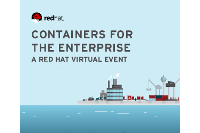The Friday Five is a weekly Red Hat® blog post with 5 of the week's top news items and ideas from or about
Red Hat and the technology industry. Consider it your weekly digest of things that caught our eye.


CHECK IT OUT:
Registration for 2017 Red Hat Summit is open
Registration is now open for the 2017 Red Hat Summit! Learn, network, and experience open source at every level with hundreds of sessions led by the best and brightest in open source, hands-on experience with our newest technologies, face-to-face interaction with product experts–or the actual builders–demonstrating the latest technologies, the chance to grow your network, reconnect with peers, and make new partnerships. The event will be in Boston at the Boston Convention and Exhibition Center, May 2-4, 2017. Early bird registration ends March 2.


CHECK IT OUT:
Containers for the Enterprise - A Red Hat virtual event
Now more than ever, we know that modern application development and deployment are tied to business growth. A business is 8 times more likely to gain share if it is at the forefront of digital maturity. Speed, security, and operational efficiency are key elements that will determine success or failure. Linux® containers, used correctly, will help your organization deliver all three. Sign up and attend Containers for the Enterprise | A Red Hat virtual event to find out how to unlock the potential of Linux containers in their enterprise. The live event will take place Thursday, January 19, 2017 at 11 a.m. ET | 4 p.m. UTC.


IN THE NEWS:
CRN - The 10 Coolest Open Source Products Of 2016
In 2016, open source products were front-and-center. A number of new offerings in containers, networking, storage and other major areas were among those that debuted during the year. At #4 is Red Hat Ceph Storage 2. Red Hat this year unveiled a major update to Ceph Storage, the company's open software-defined storage platform — the first new version of the platform since Red Hat acquired the technology in 2014. Ceph Storage 2 introduces a new storage management system and new features geared toward object storage workloads, such as new global object storage clusters that offer better data synchronization between distributed clusters and other benefits.


GOOD READ:
Red Hat Enterprise Linux blog - Five Reasons to Switch from vSphere to Red Hat Virtualization
It's time to upgrade or to renew your VMware vSphere licenses. This decision is not easy for a few reasons such as: One or more of your VMware products are end of life, or there are hundreds or thousands of virtual machines (VMs) in your environment and the costs to maintain them has significantly gone up. I have good news for you. There is a reliable and enterprise choice and switching has never been easier with the recent release of Red Hat Virtualization 4. You can run Red Hat Virtualization alongside VMware and migrate workloads in phases, perhaps starting with dev/test. Compared to competing products, Red Hat Virtualization delivers easier integration and interoperability with existing infrastructure, higher density and performance, and improved economics. Read more on the 5 reasons you should switch to Red Hat Virtualization.


RECOMMENDED READING:
The FOSS Post - Insights on Red Hat, SUSE & Canonical; The Major Linux Companies
Today, the Linux operating system is used almost everywhere, from web servers, android devices, supercomputers and to IoT devices. Linux has become more than just an operating system, and because of this, it has created huge opportunities for enterprises to benefit from. This market allowed great tech companies to be established to fulfill its needs, which gave us the 3 major Linux companies: Red Hat, SUSE and Canonical. The business model for each of the major companies was similar: selling support services and subscriptions for their own open source and Linux-based products. Since its establishment in 1993, Red Hat grown to become the biggest Linux and open source company and a key player in the open source world. Red Hat offers a lot of solutions and services, however, Red Hat also provides a lot more than products and technologies. Red Hat certifications are one of the most valuable certifications in the Linux market. If you are planning to get a career in this field, you definitely should look into the RHCSA (Red Hat Certified System Administrator) or RHCE (Red Hat Certified Engineer) courses. According to Red Hat, more than 90% of the top 500 fortune global companies rely on them for their infrastructure. The company is expecting a total revenue of around $2.4 billion for the fiscal year 2017 (which will end in February, 2017). Thus, making it–fairly–the largest open source company in the world.
執筆者紹介
Red Hat is the world’s leading provider of enterprise open source solutions, using a community-powered approach to deliver high-performing Linux, cloud, container, and Kubernetes technologies.
チャンネル別に見る
自動化
テクノロジー、チームおよび環境に関する IT 自動化の最新情報
AI (人工知能)
お客様が AI ワークロードをどこでも自由に実行することを可能にするプラットフォームについてのアップデート
オープン・ハイブリッドクラウド
ハイブリッドクラウドで柔軟に未来を築く方法をご確認ください。
セキュリティ
環境やテクノロジー全体に及ぶリスクを軽減する方法に関する最新情報
エッジコンピューティング
エッジでの運用を単純化するプラットフォームのアップデート
インフラストラクチャ
世界有数のエンタープライズ向け Linux プラットフォームの最新情報
アプリケーション
アプリケーションの最も困難な課題に対する Red Hat ソリューションの詳細
オリジナル番組
エンタープライズ向けテクノロジーのメーカーやリーダーによるストーリー
製品
ツール
試用、購入、販売
コミュニケーション
Red Hat について
エンタープライズ・オープンソース・ソリューションのプロバイダーとして世界をリードする Red Hat は、Linux、クラウド、コンテナ、Kubernetes などのテクノロジーを提供しています。Red Hat は強化されたソリューションを提供し、コアデータセンターからネットワークエッジまで、企業が複数のプラットフォームおよび環境間で容易に運用できるようにしています。
言語を選択してください
Red Hat legal and privacy links
- Red Hat について
- 採用情報
- イベント
- 各国のオフィス
- Red Hat へのお問い合わせ
- Red Hat ブログ
- ダイバーシティ、エクイティ、およびインクルージョン
- Cool Stuff Store
- Red Hat Summit

